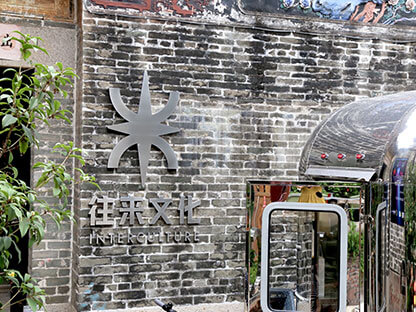Huangpu Ancient Port – a hidden jewel of Guangzhou
A twenty minutes’ taxi ride from Zhujiang New Town, or just 10 minutes from Canton Fair, can be a long travel in time: In Huangpu Ancient Port, located in Guangzhou’s Pazhou district, history is still alive. You will there see, step on and touch the origins of Canton being China’s gateway to the world.

The adjacent Huangpu Village has 1600-year history, it became prosperous as part of the ‘Maritime Silk Road‘. There is a great number of ancestral halls, ancient academies, monuments and cultural relics.
To understand Guangdong and Guangzhou and to study contemporary China’s international trade and foreign exchange, you have to learn the history of the ancient village of Huangpu ancient port.
When it comes to ‘Huangpu Ancient port’, many people would confuse it with the location of ‘Huangpu Military Academy’. However, they are distinctly separate locations. Those names of Huangpu Military Academy, Huangpu port, Huangpu Boulevard are all originated from Huangpu Ancient port.
In 1757, Guangzhou officially became the only international trade port in China when the Qing Court issued an order to implement the Canton System in 1757. Foreign ships were allowed to dock only at Huangpu Ancient Port for unloading, dealing with customs clearance, and return procedures.

From 1757 to 1842, ships from Europe, the Americas, Australia, South-East Asia and Japan all anchored at the Huangpu Ancient port. Mighty fleets queued up several nautical miles long. At that time, Huangpu village was a crowded, prosperous, wealthy ancient town with many shops and night markets that stayed open all day and all night.
After the First Opium War, China was forced to open more trade ports including Shanghai whose status gradually surpassed that of Huangpu port. At the same time, due to the blockage and narrowing of the river, the boat port had to be moved to Changzhou Island, where the Huangpu Military Academy is currently located.

Lin Yutang writes on “My Country and My People” that in the study of any period of literature or of any epoch of history, Individual destiny could be the epitome of their times, which makes history very cordial and easy to understand.

In contemporary China, there were many famous families and celebrities who lived in Huangpu Ancient Port. The most eminent person of Huangpu Ancient Port was Hu Xuanze from the Hu family. He was the first Chinese consul abroad- being the Chinese Consul General in Singapore. Due to his outstanding diplomatic skills, he was subsequently appointed by Russia and Japan as the Consul General in Singapore. Hu Xuanze is hence not only the first Chinese consul abroad, but also the first person in the history of international diplomacy to become a consul of three countries. The Hu family’s Ancestral Hall is a very elegant and dignified Lingnan building in Hui-style. There is an exhibition of Hu Xuanze in the Ancestral Hall.

The Huangpu Ancient village is a place where many celebrities emerged. Liang Jingguo from the Liang family was one of the founders of the Thirteen Factories and his great-grandson, Liang Cheng, was the a founding father of Tsinghua University. The Liang family’s Ancestral Hall is not far from the Ancentral Hall of the Hu family. It is now an exhibition hall on the culture and history of Huangpu Ancient Village, and is worth a visit.

There is a university in the Huangpu Ancient Village, which is one of the oldest maritime universities in China– the Guangzhou Maritime University.
The houses, plants, temples and ancestral halls in the Huangpu Village give people a sense of tranquility and simplicity, which are full of charm of Lingnan water village. The well-preserved ancient ancestral halls are properly retrofitted and used. For example, they have now become an artist’s studio, an intangible cultural heritage exhibition hall, a Lingnan Arts and Crafts district, an exhibition hall on the culture and history of Huangpu Ancient Village, etc. So, tourists should not only visit the ancestral halls and ancient buildings when they visit the Huangpu Ancient Village, but also the artist’s studio and the contemporary art exhibitions.

It is worth mentioning here that the InterCulture space is located on the left side of the Hu family’s Ancestral Hall. Its contemporary minimalist style gives a unique charm to the ancient temple, which has a history of more than 400 years.

Behind the entrance there is a courtyard (in Chinese:skywell), giving people a sense that the sky, the earth, and the building are integrated. Looking through the floor-to-ceiling glass door you can see the co-working office area. On the right is an exhibition space where various experimental contemporary art exhibitions are regularly held.

On the left side of the office, you can find an ancient well with crystal clear water in it. Facing this well is a clean and simple room where guests can reside. InterCulture invites one or two professional individuals from different fields for its thinkers-residency program, including philosophers, economists, anthropologists, artists, writers, curators, designers, musicians, filmmakers, etc.

The InterCulture space regularly holds contemporary art exhibition, thinkers’ dining table, cross-cultural concerts and other cultural exchange events.


If you are interested in the thinkers’ residency program at InterCulture Space in the Huangpu Ancient Port, please contact us:
Address:Hu Ancestral Hall, No.8 Buxiangli, Huangpu Ancient Port, Haizhu District, Guangzhou, China.
Email: info@interculture-eucn.com




